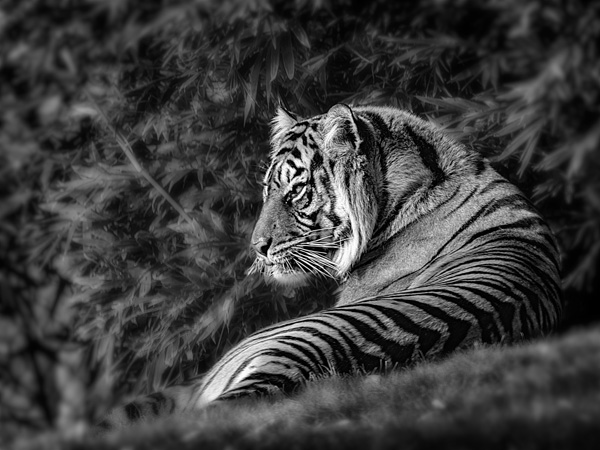
by successfulbob | bird photography, black & white, Lumix G9, photography, photography education, photography gear, wildlife photography
Creating Good Animal Photos from a Captive Environment – Part Two
Last zoo post I was sharing some ideas on learning wildlife photography skills while photographing captive animals. See Part One here
 I followed this Great White Egret until the reflection was completed from beak to tail. The black and white treatment brings the bird to the highest contrast attention
I followed this Great White Egret until the reflection was completed from beak to tail. The black and white treatment brings the bird to the highest contrast attention
One of the essential skills is to learn to queue on behavior. This means learning to see when the behavior will change. What will happen when you look at the feathers shaking in a certain way or excrement fall from a bird. These are indicators that signal flight or a change of wing position and either of those can lead to a more interesting photograph.
 Processed this image to BW also. Slight sharpening of the tiger using Skylum software as an Adobe Photoshop plug-in. I also softened the foreground and background with a gaussian blur as well as a darkening Curves layer Significant help for me that increased my ‘keepers’ in photographing images of animals in zoos, parks and in the wild was a lens that has a long reach. The micro 4/3rds Panasonic Lumix system has been an enormous help. Being able to handhold an 800mm equivalent lens makes a huge difference because of the mobility and distance from the animals. The less you disturb your prey and having the ability to still fill the frame is golden.
Processed this image to BW also. Slight sharpening of the tiger using Skylum software as an Adobe Photoshop plug-in. I also softened the foreground and background with a gaussian blur as well as a darkening Curves layer Significant help for me that increased my ‘keepers’ in photographing images of animals in zoos, parks and in the wild was a lens that has a long reach. The micro 4/3rds Panasonic Lumix system has been an enormous help. Being able to handhold an 800mm equivalent lens makes a huge difference because of the mobility and distance from the animals. The less you disturb your prey and having the ability to still fill the frame is golden.
 Don’t lose sight of other opportunities when photographing wildlife. This split tree trunk was good for an abstract look of colors and tones.
Don’t lose sight of other opportunities when photographing wildlife. This split tree trunk was good for an abstract look of colors and tones.
My main camera these days is the Lumix G9. The stabilization system gives an extra six and one-half to seven stops of hand-holdability. This means that hand holding a lens of 800mm equivalent at 1/60th of a second is very possible with sharp results. My favorite lens is a zoom lens – Leica 100-400mm f4.0-6.3
Yours in Creative Photography, Bob
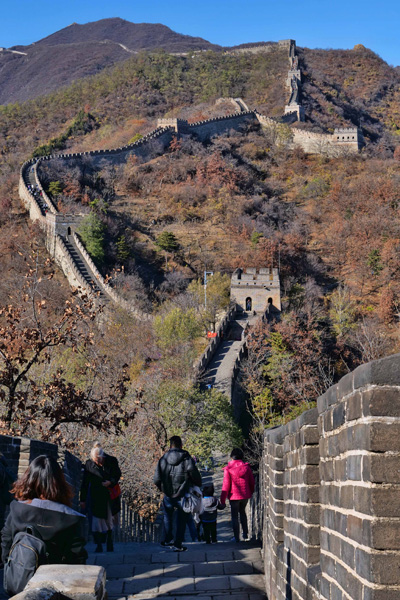
by successfulbob | architectural photography, Guest Post, Lumix G9, travel photography
China through the Eyes of Ken MacAdams – Part One
Ken is currently wending his way through China and shares news and images from his travels here on Succssful-Photographer.
The 12 + hour flight to China will tweek your psychological time clock, not matter how you cut it. We welcomed deplaning in Beijing, and getting our feet back on the ground. Flying from the USA, we’d crossed the International Date Line, so lost a day. After breezing through immigration, we stepped out into the terminal, into the face of new smells and sights. Like the reality of the time difference, once you step off the gateway, you know you’re not in Kansas.

Forbidden City gate with the modern city in the background. Smog is often present – and many people wear face masks when walking about. All Images in this post © Ken MacAdams 2018 All Rights Reserved
Personal Photography Project
This marks my 5th sojourn in China, and each visit is an enriching experience. My visits now are part of a personal photography project, in which I’m documenting the tremendous changes going on in this vast land. China has often been ‘off limits’ to foreigners, and in recent times it wasn’t until the late 1980’s that foreigners could obtain visas to travel here. My first visit was in 2000. Already changes were happening as the ‘New China’ came out from under the repression of the Cultural Revolution – an era that almost put China back into the Dark Ages.
 Woman dancing to music with a banner flag in one of the many parks.
Woman dancing to music with a banner flag in one of the many parks.We’d planned only a short sojourn in Beijing, but wanted to experience a different section of the Great Wall, and see some of the changes around the city since our first visit here. A teacher I’d met last year picked us up at the airport and shuttled us to a motel near his apartment. Foreigners must stay only at State approved hotels, as Big Brother keeps a close eye on affairs here. I’m not intimidated by it, just aware that as I travel about, my every move is documented and tracked. My wife is with me, and we’re here on 10 year multiple entry tourist visas, with a maximum stay of 60 days per visit.
 Hiking on the Great Wall from one watchtower looking back down the mountainside.
Hiking on the Great Wall from one watchtower looking back down the mountainside. This view of the Wall gives you a perspective of just how much hiking you have ahead of you!!
This view of the Wall gives you a perspective of just how much hiking you have ahead of you!! The Great Wall
Our friend had arranged for a driver to shuttle us out to the Matianyu section of the Wall. Luck presented us with one of the sunniest days I’ve ever experienced in this area, with brilliant blue cloudless skies. This section of the Wall climbs over 3,400 ft. as it clings to the spine of the rugged mountains. A modern gondola whisked us part way up the mountainside, and then it was time to hike! We logged over 3 miles of semi-strenuous hiking during our visit, poking around watchtowers, savoring the grand vistas, and marveling at the thought of those who labored so hard to build this Wonder of the World. Originally constructed to prevent fierce raiding tribesmen from the north from plundering the city states to the south, the wall stretches from the Pacific Ocean to the east, several thousand miles inland.
Ken has always loved to travel, so when he made a common connection with the fact that either a long day pounding the streets of some foreign city, or shooting the last dance at a wedding, a good part of his physical

weariness came from lugging around his big heavy DSLR. That’s when he started looking at alternatives – and ended up selecting Panasonic Lumix Micro Four Thirds gear.
Ken is rarely without a camera, and the next great photo travel experience – whether local or abroad – is always in the back of his mind! A longtime resident of the Four Corners, and when he’s not out on the road, he enjoys some of the great outdoor opportunities found there – mountain biking, hiking, and Jeeping.
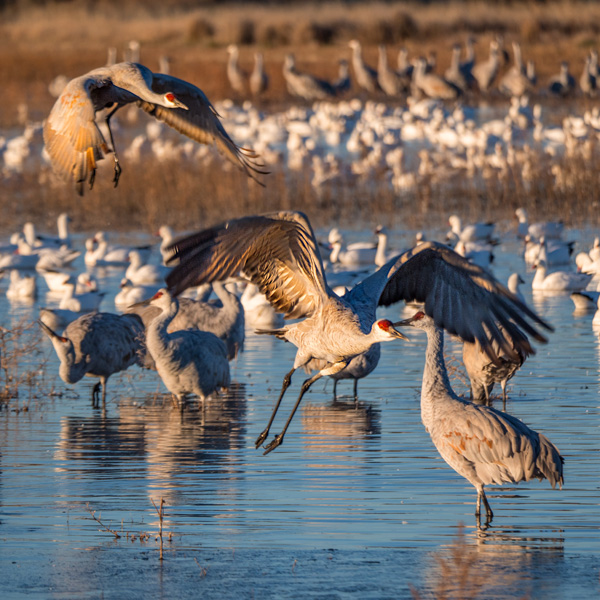
by successfulbob | bird photography, Lumix G9, travel photography, wildlife photography
Festival of the Cranes
Bosque del Apache National Wildlife Refuge – Part Three
I enjoy spending time with wildlife.
Watching. Waiting. Learning.
To get the best wildlife images it is important to study the behavior patterns of your prey. Especially in avian photography. Learning when a bird is about to make a move leads to obtaining more than a portrait. Portraits are cool, but my favorite images are highlighting behavior. A mating dance. A flight. A landing. Feeding or grooming all lend more to the captured image in my opinion.
These images are from the Festival of the Cranes in Socorro, New Mexico just a bit south of Albuquerque. I shared pictures from the event, but the previous ones were of Snow Geese. These are the stars of the show, Sandhill Cranes.
Let me know what you think!
 In for a landing during first light at the first pond – Bosque del Apache NWR
In for a landing during first light at the first pond – Bosque del Apache NWR
 Sandhill Crane in flight (with a couple of snow geese interlopers in the background)
Sandhill Crane in flight (with a couple of snow geese interlopers in the background)
 In the warm glow of sunrise here’s the classic capture of three Sandhills with the three wing positions
In the warm glow of sunrise here’s the classic capture of three Sandhills with the three wing positions
More Sandhills in the next day or so. For more from the Bosque NWR see these posts with the Snow Geese.
Bosque Part One
Bosque Part Two
The previous posts have the information on the camera gear and links to find it.
Yours in Creative Photography, Bob
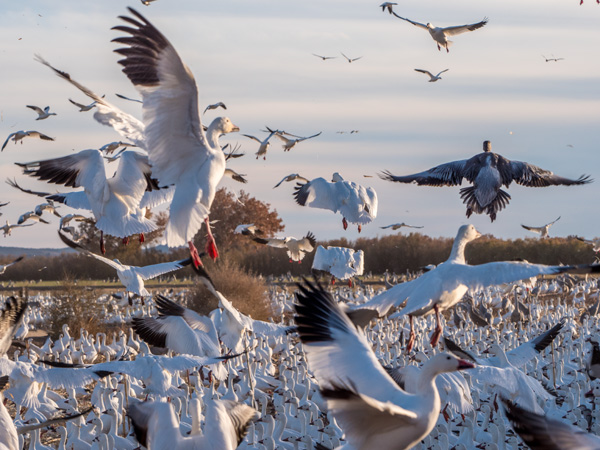
by successfulbob | bird photography, Lumix G9, LumixGH5, photography, photography gear, travel photography, wildlife photography
Bosque Del Apache National Wildlife Refuge
Snow Geese Part Two
With twenty-thousand plus snow geese winging their way around the Bosque Del Apache National Wildlife Refuge it was a fantastic couple of days of sights and sounds. Sometimes it was quite overwhelming. On several occasions I had to put the cameras down to just experience nature in its pure form.
I’ve found there is a layer of distance that appears much larger than the six to eight physical inches when I put my face behind a camera — a certain detachment. This distance enables other photographers and me to do things like cover disasters, wars or record infant demises through organizations such as **Now I Lay Me Down To Sleep. This is an important feature, but it can occasionally interfere with the enjoyment of the moment that is unfolding in front of us.
More Snow Geese photos to share…
 A solitary Sandhill Crane glides in over a pond of snow geese
A solitary Sandhill Crane glides in over a pond of snow geese
 Snow geese in flight
Snow geese in flight
 Take off!
Take off!
 Kinda reminds me of that famous movie from Alfred Hitchcock!
Kinda reminds me of that famous movie from Alfred Hitchcock!
To make successful wildlife photographs, I would suggest that you spend a fair amount of time studying their behavior long before you pick up your camera to try and capture images. I’m a big fan of bird behavior vs. a straight portrait, although portraits have their place. Being able to predict when a bird will fly, open its wings or display for another will make your photographs come to life. Having a lens with a long reach works to help you fill the frame without disturbing the natural behavior. See my gear below which gives me an 800mm equivalent which is handholdable for capture.
Images were made with Panasonic cameras. Most often the LUMIX G Leica DG Vario-Elmar Professional Lens, 100-400MM, F4.0-6.3 ASPH mounted on the Lumix G9 and the Lumix GH5 for a second body. I had the chance to try out the Leica DG Vario-Elamarit 50-200mm 2.8-40 lens I am working toward getting this lens.
Next up the Sandhill Cranes!!
Yours in Creative Photography, Bob
** If you want to give back to your community think about photographing for NILMDTS. It is a very rewarding, if difficult mission.
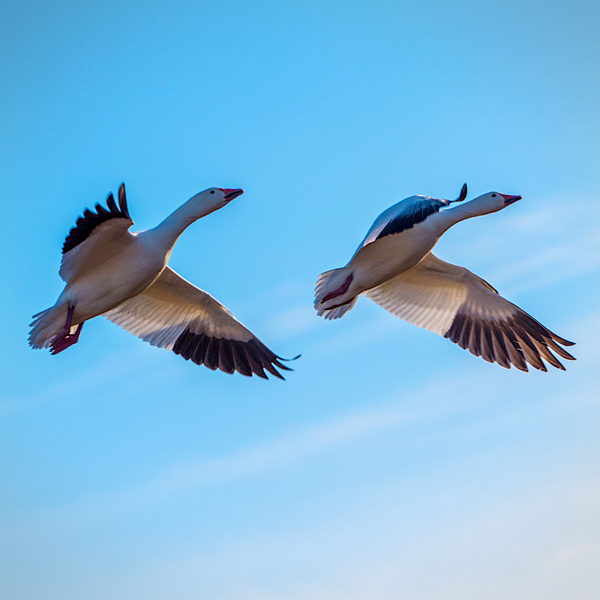
by successfulbob | bird photography, Lumix G9, LumixGH5, photography, photography gear, travel photography, wildlife photography
Festival of the Cranes
Bosque Del Apache National Wildlife Refuge
White Snow Geese must have gotten the invitation too.
I was in Socorro, New Mexico at the Festival of the Cranes hanging with the massive flocks of birds and a mass of photographers. Gotta tell you I felt like the Snow Goose whisperer during my workshop. The 10,000-plus Snow geese seemed to be following me around the refuge. Seeing them move as a group and fly mass ascensions from place to place was magical! Here are a few photos to help visually tell the story.
 If you look closely, you can see the water droplets on the goose’s body
If you look closely, you can see the water droplets on the goose’s body
 A sandhill crane works to land over a pile of snow geese. The guides at the Festival of the Cranes consider the geese interlopers. (And there were about 20,000 plus!)
A sandhill crane works to land over a pile of snow geese. The guides at the Festival of the Cranes consider the geese interlopers. (And there were about 20,000 plus!)
 A pair of snow geese in flight
A pair of snow geese in flight
This trip is my second time at the Bosque Del Apache National Wildlife Preserve, and I certainly hope it won’t be my last. It is a well-managed area with wildlife throughout the year. Each year the cranes and geese return on their annual migration just before Thanksgiving. It is a sight to behold when 20,000 geese take to the air. I’ll share some photos of that spectacle in a day or so. To tell the truth, I stopped making images for a while to experience the display of so many birds in flight, or as my friend, Skip Cohen says, “Take ‘Neurochromes’ and burn the images into your brain.”
Images were made with Panasonic cameras. Most often the LUMIX G Leica DG Vario-Elmar Professional Lens, 100-400MM, F4.0-6.3 ASPH mounted on the Lumix G9 and the Lumix GH5 for a second body. I had the chance to try out the Leica DG Vario-Elamarit 50-200mm 2.8-40 lens I am now lusting after this… A sweet piece of glass!
Have a happy Thanksgiving!
Yours in Creative Photography, Bob
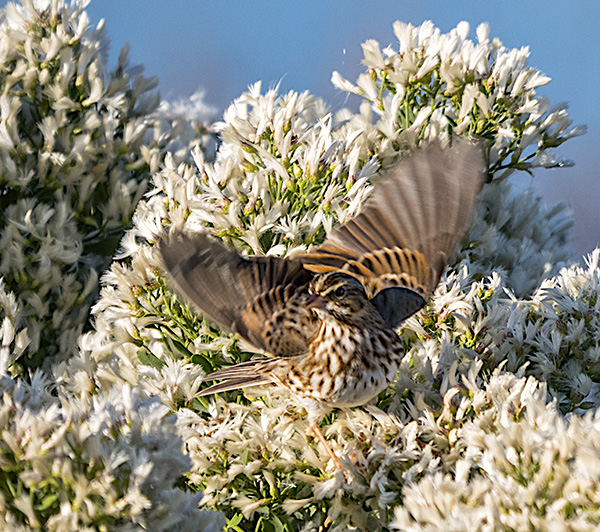
by successfulbob | bird photography, Lumix G9, photography, photography gear, travel photography, wildlife photography
Bombay Hook National Wildlife Refuge – Smyrna, Delaware
I’ve been a bit remiss in posting. Travel for speaking. Travel for family visit. And catching up upon return fronfrom the travel makes Bob a bad boy. But, I’m back and with plans to have more posts even when traveling to judge images &speak in Oregon and do a seminar and a couple workshops for the Festival of the Cranes in Socorro, New Mexico in the middle of November. We’ll see how that works out!
 Dunlin Sandpipers enjoying breakfast
Dunlin Sandpipers enjoying breakfast
While on the family visit I made it up to the Bombay Hook National Wildlife Refuge. I spent the day making images and talking photography with my friend Ned Levi. This was the first time we met in person. I highly recommend spending quality time with your peers. It’s wonderful how much you can learn from each other. (learn more about Ned and his blog)
 Thought this was an interesting formation of the Canada Geese. I normally enjoy them mor eisolatedbut the overlap of the birds is kida cool. Watcha’ think??
Thought this was an interesting formation of the Canada Geese. I normally enjoy them mor eisolatedbut the overlap of the birds is kida cool. Watcha’ think??
If you have not spent time in wildlife refuges there are some protocols that make the system work for everyone. If you do go please follow the rules and regs. use the longest lens you have and do your best to not disturb the wildlife. There’s an expression, “Take only images, leave only footprints.” Not sure I have the exact words but you understand the sentiment.
This is from the Refuge website and the rules are much the same in all refuges.
Know Before You Go
- The wildlife drive is open from 1/2 hour before sunrise to 1/2 hour after sunset daily.
- The visitor center is open weekdays from 8:00 a.m. to 4:00 p.m. year round.
- During spring and fall weekends, the visitor center is open Saturday and Sunday from 9:00 a.m. to 5:00 p.m.
- The visitor center is handicapped accessible and has educational displays and videos.
- The visitor center is closed on Federal Holidays.
- The visitor center is closed on weekends during July, August, mid-December, January, and February.
- Check the website or call to find out about refuge road closures during bad weather and hunting season. During summer months, visitor should bring insect repellent and wear long-sleeve shirts and long pants.
- To protect wildlife and their habitat and to provide the best opportunities in wildlife observation and photography, it is important not to disturb, injure, or damage plants and animals on the refuge. In fact, it is a prohibited act as stated in 50 CFR 27.51. This disturbance includes flushing birds and other wildlife or using mechanical or electronic devices to lure birds closer for observation or photography. Please remember to take only memories and photographs and leave only footprints.
- Unmanned aircraft systems (Drones) are prohibited.
 A simple houe wren was dancing in and out of the flowering bush. Behavior and movement photos are my aim.
A simple houe wren was dancing in and out of the flowering bush. Behavior and movement photos are my aim.
Images were made with the PANASONIC LUMIX G Leica DG Vario-Elmar Professional Lens, 100-400MM, F4.0-6.3 ASPH mounted on the Lumix G9.
Yours in Creative Photography, bob

 I followed this Great White Egret until the reflection was completed from beak to tail. The black and white treatment brings the bird to the highest contrast attention
I followed this Great White Egret until the reflection was completed from beak to tail. The black and white treatment brings the bird to the highest contrast attention Processed this image to BW also. Slight sharpening of the tiger using Skylum software as an Adobe Photoshop plug-in. I also softened the foreground and background with a gaussian blur as well as a darkening Curves layer Significant help for me that increased my ‘keepers’ in photographing images of animals in zoos, parks and in the wild was a lens that has a long reach. The micro 4/3rds Panasonic Lumix system has been an enormous help. Being able to handhold an 800mm equivalent lens makes a huge difference because of the mobility and distance from the animals. The less you disturb your prey and having the ability to still fill the frame is golden.
Processed this image to BW also. Slight sharpening of the tiger using Skylum software as an Adobe Photoshop plug-in. I also softened the foreground and background with a gaussian blur as well as a darkening Curves layer Significant help for me that increased my ‘keepers’ in photographing images of animals in zoos, parks and in the wild was a lens that has a long reach. The micro 4/3rds Panasonic Lumix system has been an enormous help. Being able to handhold an 800mm equivalent lens makes a huge difference because of the mobility and distance from the animals. The less you disturb your prey and having the ability to still fill the frame is golden. Don’t lose sight of other opportunities when photographing wildlife. This split tree trunk was good for an abstract look of colors and tones.
Don’t lose sight of other opportunities when photographing wildlife. This split tree trunk was good for an abstract look of colors and tones.


























